
|
Mother Nature As the Ultimate Terrorist and the Consummate Creator
Richard L. Howey, Wyoming, USA |
Living at 7,200 feet surrounded by a circle of mountains, we expect, even if we do not fully accept, unorthodox weather. However, sometimes, it becomes sufficiently extreme and inconvenient to tax even the most patient souls. Wind is a factor always to be taken into account, but when it gets up to more than 40 mph, it becomes a severe annoyance. On the summit highway above us, there were gusts of 101 mph across the highway. Down here in the valley, it only gusted to 70 that day. Now, imagine getting snow along with such “breezes” and you’ll get a notion of what the last couple of days here have been like. We had winds gusting up to 60 mph and a snowfall of about 26 inches–in other words, a blizzard (and I’m not referring to the Dairy Queen delight here).
Being of a mature age (83) and on oxygen 24/7, I was concerned about the strong possibility of a power outage. So, I got my oxygen provider to bring out a spare cylinder as a backup for such a nightmare. If the power went out, so would all of our sources of heat. Thus, in an instant, all of our cozy, bourgeois comforts could be suspended. Fortunately, this did not happen but, nonetheless, the possibility reminded me of how much we are at the mercy of Mother Nature’s temper tantrums. As Dr. Fauci, the distinguished epidemiologist said recently in an interview: 'Historically, the worst bioterrorist has been nature itself'
Before I proceed to discuss some of those, let me do a bit of conceptual housekeeping. I realize that referring to Nature as “Mother Nature” is a kind of objectification suggesting an intelligence, will, and power. I do not see Nature as having the first two, but certainly it does have enormous power. So, my reference to “Mother Nature” is simply a figure of speech and also not intended to offend any feminists either. The case for Nature being a terrorist is relatively straightforward and easy to make and aspects of it are, from our human point of view, horrific. So, to maintain a balance and a semblance of sanity, we will also look at some of the most beautiful marvels which Nature produces.
In addition, due to the insanely chaotic political situation in this country for the past five years, there has developed a large scale fad for demanding “transparency”. Talking about Nature as though it were some kind of super entity covertly suggests that it does have a kind of intelligence that can create and direct the course of phenomena. This is a highly appealing conception and one which dates from ancient times. The Greeks developed a sophisticated notion of teleology and thought of Nature not only as intelligent, but as having purpose and providing meaning for observed phenomena. In the 19th Century and especially in England, we see it flowering into a rich spiritual view, given the name of Natural Theology. Some scientists embraced this viewpoint and gave it a kind of special importance as a distinct ideology. Many ordinary religious believers embraced it, in part, because of its aesthetic appeal, but also because it meant, one didn’t have to spend Sundays in a drafty stone cathedral listening to a dry as dust sermon which seemed largely irrelevant. Instead, one could take a stroll through the forest or splash along a seashore, collect shells, go hunting for butterflies, mushrooms, wildflowers, or keep a record of different species of birds. All of these undertakings could be defended as being a celebration of the divinity of Nature. This celebration did, of course, depend upon a romanticizing of Nature, a focus on the beauty, the creativity, the harmony, the cooperation between species, and the glory and pervasiveness of patterns everywhere. Nature, understood largely as distinct and separate from Man, was thought of as God’s greatest creation and irrefutable proof of his greatness and beneficence. Now, for the transparency which I spoke of: I find such a view very appealing apart from its theism; that is, the beauty and ingenuity of Nature has an extraordinary aesthetic appeal for me. But, in the end, I have to reject teleology, precisely because it depends upon the romanticizing which I mentioned above. What is lacking in such a view is the horrors, the ugliness, the enormous destructiveness and utter indifference of Nature and it is this side which we will be taking a look at here.
First, consider physical phenomena that can radically disrupt the lives and activities of human beings: massive snow storms, tsunamis, hurricanes, avalanches, volcanos, flooding, wildfires, hailstorms, heat waves, periods of subzero temperatures, sea level rises, silting of waterways, warming of the sea producing changes in ocean currents, decreasing salinity of the oceans due to massive melting of freshwater ice caps and glaciers, drought, tornados, earthquakes, landslides, and solar flares which disrupt communication systems. Probably, with a bit of effort, one can come up with a few more. Such a list might make an alien take a second look and say, “Hey, this is not a desirable planet in the least, let’s keep looking.”
However, I am going to focus here more on biological forms of terrorism which Mother Nature employs. A major impetus behind the origin of science was the dual desire of understanding and the hope to exercise control. The use of mathematics and physics to understand some basic phenomena of our world helped us be able to plan to mitigate some of the worst effects of certain physical phenomena; for example, we learned to build sea walls, pipe water long distances, build shelters that were resistant to some kinds of extreme weather, and build roadways that allowed communities to share goods and knowledge.
The kind of biological warfare waged against us was much more difficult to comprehend and deal with because many of the agents which posed a threat to us were unknown and inaccessible until the invention of the microscope. Mosquitos, flies, rats, and mice were regarded as pests, but there was no way of knowing that they could be disease vectors until the 19th Century. With the advent of the microscope, pathology became a major aspect of medicine and discovery after discovery forced us to realize how biologically vulnerable and fragile we are. Parasites were known previously, but now micro-parasites added a whole new dimension. Bacteria and fungi became suspects in ways that we had never dreamed of. In the 20th Century, the invention of the electron microscope opened up yet a another new dimension, named, virology. Suddenly, we seemed in a constant battle with Nature and, as we learned more about our own constitution as organisms, we had to begin making complex and difficult decisions. There are micro-organisms that are of benefit to us and are, in fact, essential for our survival. There are more bacteria living in us than the number of cells which constitute us. As we learned more and more about the immune system, we came to marvel at the range of defenses which we have as an organism. Disturbingly, however, we also came to discover that the immune system could at times go awry and overreact, thus attacking us. We also found that beneficial bacteria could at times also become enemies. Then in 1918, we encountered a transformative enemy–”Spanish flu” which turned out to be an influenza virus which had appropriated certain avian genes and thus also became known as “bird flu”. This virus infected 500,000,000 people, about 1/3 of the Earth’s population at that time. It is estimated to have caused 50,000,000 deaths and over 650,000 in the United States alone. Naturally, all sorts of “snake oil” salesmen produced concoctions which were sold as “cures” or treatments. Interestingly, the best precaution seemed to be the wearing of masks and the federal government began distributing gauze masks which citizens were ordered to wear. Schools, theaters, and many businesses were closed. Treatment was symptomatic; aspirin given for fever, oxygen for breathing failure.
During the Second World War, many soldiers succumbed to hideous wounds which became infected. Although penicillin had been discovered in 1928, it wasn’t until a collaboration between the United States and the United Kingdom that real production got underway. However, even then at the end of 1942, there were only enough doses to treat about 100 soldiers. In 1943, production ramped up so that the Allied Command was supplied with the full range of doses which it needed. This saved many lives, but ended up creating a major medical problem in the long run. We now know that many bacteria can modify themselves or mutate in such a manner that they become resistant to the effects of the antibiotic. The misuse and overuse of these medicines has led to the disturbing situation which we now face of confronting bacteria which are resistant to virtually all the antibiotics that we have in our cabinet of weapons. Furthermore, some of the more recent and most powerful types can produce extreme and highly undesirable side-effects. It is this factor of the extraordinary ability of bacteria and viruses to mutate that makes them so dangerous and we shall take a look at that in a bit. The distinguished molecular biologist and Nobel Laureate, Joshua Lederberg once said: “The single biggest threat to man's continued dominance on the planet is the virus.”
However, at this point, let’s consider some of the parasites which attack humans. There are three main types: 1) protists, 2) helminths or worms and 3) ectoparasites such as fleas and ticks.
1) Protists
There is a tiny amoeba of the acathamoeba group which can infect the skin, the eye, and the brain. It is global and found in soil and water. It can be contracted by washing contact lenses in tap water which contains this tiny beast.
Then we also have Babesiosis which affects red blood cells, Balantidiasis caused by Balantidum (a single celled parasite) which can infect the intestines, Amoebiasis caused by the parasite Entamoeba hystolica which affects the intestines, Giardiasis which can be ingested by drinking water contaminated with feces containing dormant cysts which can lodge in the small intestine and cause recurrent episodes. This is especially deceptive in that the water may be crystal clear in a high alpine stream, but the hiker or camper may not realize that elk, moose, deer or other animals may have deposited fecal material containing the parasite in the “pure”, tempting, clear, ice cold water. In addition, there is Leishmaniasis and this protist can attack the mucous membranes of the mouth and throat. It is transmitted by sandflies and can be fatal. One of the nastiest infections is Primary Amoebic Meningoencephalitis cause by a tiny amoeba Naegleria fowleri and is known as the “brain eater”. It is virtually always fatal and is transmitted through breathing in contaminated water in swimming holes or pools.
One of the most notorious protist parasites is Plasmodium which causes malaria and has caused millions of deaths. It is carried by the Anopheles mosquito.
Trichomoniasis is a sexually transmitted disease and it usually affects the female urogenital area.
Trypanomiasis or “sleeping sickness” is transmitted by an unusual protozoan parasite of the trypanosome group which is fatal if untreated. When slave traders were operating at full bore in Africa, such natives were usually rejected as “lazy”. These parasites have been extensively studied and when observed under the microscope have a rather fascinating appearance with an undulating membrane along one edge.

And finally, there is Chagas fever which transmits the parasite by an insect bite from the “kissing bug”. This parasite is one of the trypanosomes, namely, Trypanosoma cruzi. This disease affects, the heart, colon, nerves, muscles, and blood. In other words, it is a nightmare. It is thought that Darwin may have contracted Chagas fever during the South American portion of the Beagle expedition. However, alternate theories for his illness have been proposed, but the Chagas explanation remains a strong contender.
When we consider parasitic worms, we need to give thought to what we eat and drink.
Anisakiasis is a condition caused by worms that can enter into the stomach and intestines from eating fresh or improperly cooked sea food such as squid or marine fish. However, eating freshwater fish is not necessarily a solution unless one insures that it is properly cooked, for there is a danger of infection from the Chinese liver fluke. Furthermore, there is a risk of getting the eggs of the giant kidney worm from freshwater fish that is undercooked. And for the fans of sushi there is the possibility of adding the Diphyllbothriasis tapeworm to your internal collection.
The cast of parasitic characters in the realm of worms is diverse and full of nasties.
The guinea worm is a particularly nasty parasite and it causes blisters and ulcers in tissue and muscles which are sometimes visible through the skin. These worms can achieve a considerable length and were often removed by making a small incision and using a stick to carefully unwind the worm taking care not to break it off, since any remaining portions can decay in the tissue causing severe pain and more tissue damage and infection. However, when concerned individuals and groups team up to address such problems as this parasite, amazing accomplishments are possible. It was estimated that in 1986, there were about 3.5 million cases in Asia and Africa. The Jimmy and Rosalynn Carter Foundation resolved to tackle such problems and by 2020, the number of cases reported worldwide had dwindled to 27!!
In addition, there is a wide variety of pinworms, tapeworms, hookworms, flukes, and filarial worms that are transmitted by contaminated food and/or water in areas with poor living conditions where animal and insect feces containing eggs or laravae in the soil and water are a major problem especially in underdeveloped parts of the world.
There is also river blindness caused by a small worm transmitted by the bite of a blackfly. It occurs mostly in Africa. Lung flukes can be gotten from eating raw or undercooked freshwater crustaceans and are also capable of attacking the central nervous system. Another fairly common parasitic disease is schistosomiasis or “snail fever” resulting from exposure to freshwater snails which have a trematode blood fluke worm.
In the U.S., most of us grew up with the caution not to eat undercooked pork because of trichinosis caused by a roundworm; it produces fever and muscle pain and severe intestinal problems. There are also tapeworms which occur in beef and pork and again can be a problem in undercooked meat. These worms can affect not only the intestines but the lungs and liver as well.
By this point, I am sure you have converted to vegetarianism; however, that doesn’t make you completely safe either, since you can get parasitic worm infections from watercress among other aquatic plants.
However, there is one other parasitic worm that deserves mention in such a discussion as this; it is a filarial worm that produces horrific effects and the extreme cases are almost beyond imagining. It is transmitted by mosquitos; another reason to exterminate mosquitos. So, for the weak of heart or stomach, you may wish to skip clicking on the links to these next four images.




Next, let’s take a brief look at ectoparasites. Ringworm is sometimes mistaken for a worm but is, in fact, a fungal infection.
The ectoparasites are probably the most familiar to Americans; fleas, ticks, head lice, body lice, and crab lice. These last inhabit what Monty Python refers to as the areas of the “naughty bits”.

However, there is another interesting little ectoparasite which few have seen because it is microscopic, yet quite common and it lives in the eyelashes and eyebrows. It is thought that almost every human has some of these critters living on them. Too many can produce irritations which may require treatment, but ordinarily, they are fairly benign. However, they won’t win any beauty contests; I’ll show you two images.


As stated earlier, the greatest threat comes from the viruses and we are now seeing a major global catastrophe in relation to COVID19 which is a novel Corona virus; that is, it was not of a type definitively known or described previously. As a consequence, there is great deal about it that was initially unknown and still remains to be discovered. One of the greatest concerns is its ability to mutate rapidly and form new strains which may end up not being as susceptible to the vaccines as we might hope. The fact that this virus and its variants have spread to virtually every country in the world is of overwhelming concern for several reasons. First of all, poorer countries don’t have sufficient supplies of the vaccine and many cannot afford them in the quantities needed. The international efforts by W.H.O. and agencies of the United Nations and various charities are very important, but sadly insufficient. This situation creates a progressively greater danger by having large segments of unvaccinated populations in which the virus finds means to produce new variants some of which may be even more lethal. Anyone in these countries who contracts a variant and then travels can spread it to countries in which it had not been previously present. In this Age of Greed, companies that produce the vaccines have withheld information regarding manufacture in order to make massive profits. The open dissemination of this information could save millions of lives and help to end the pandemic. Unfortunately, this is not a strategy that appeals to corporations and their stockholders. In the end, we may gradually begin to be able to contain the spread of COVID, but who knows what other viral nightmares are out there waiting for us. God forbid that we get a virus as nasty as COVID which is as transmissible as the “Spanish flu” virus was. Or, since we are considering nightmare scenarios, image an Ebola-like virus, which produces hideous hemorrhagic fever such that the victim bleeds from virtually all parts of the body and imagine also that it has a high transmission rate–then we really will experience Hell on Earth.
From the above, it is clear what Fauci and Lederberg meant about Nature and, in particular, viruses. However, perhaps it’s time now to turn to the other side of Mother Nature, the “consummate creator”. The ancient Hindus conceived of a god, Shiva, who was both creator and destroyer. His dance of destruction was so that things could then be created in a more perfect fashion. So, we’ve seen the destructive side, let’s now take a look at the creative side and some of the amazing features of nature, some of which we, as humans, have been able to further transform through our creative abilities for, we have to remember, that we are also a part of Nature and we too create and destroy.
Let’s look at some hidden marvels beginning with the spicule, a silica skeletal structure, from a glass sponge, Hyalonema. It has been isolated by dissolving out the surrounding tissue and then photographing it using Nomarski Differential Interference Contrast (DIC).
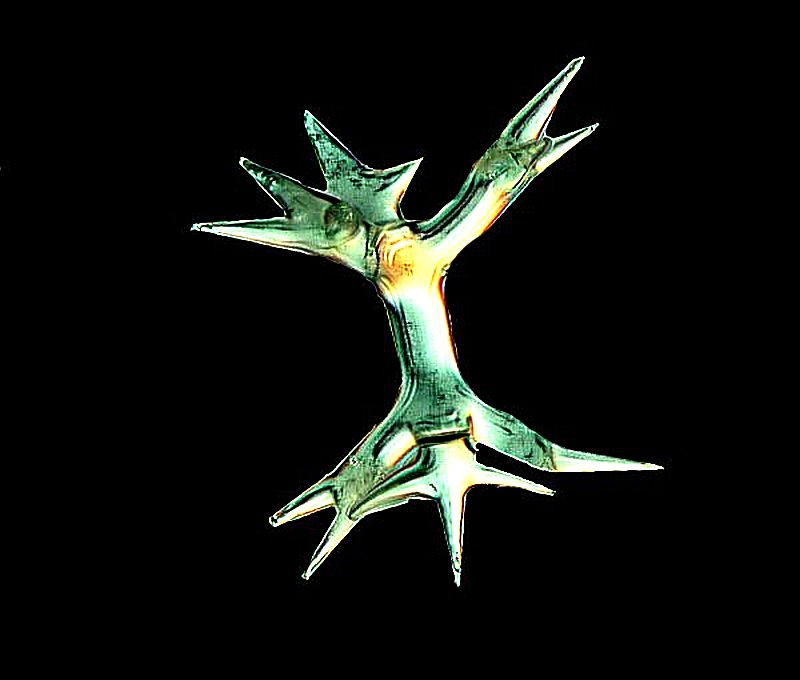
Some glass sponges can be architectural wonders in themselves. A splendid example is Euplectella aspergillum. I think this rivals anything one might find in Dubai. First, I’ll show you the complete skeleton of the sponge and then a closeup in which you can see the intricate detail of its construction.

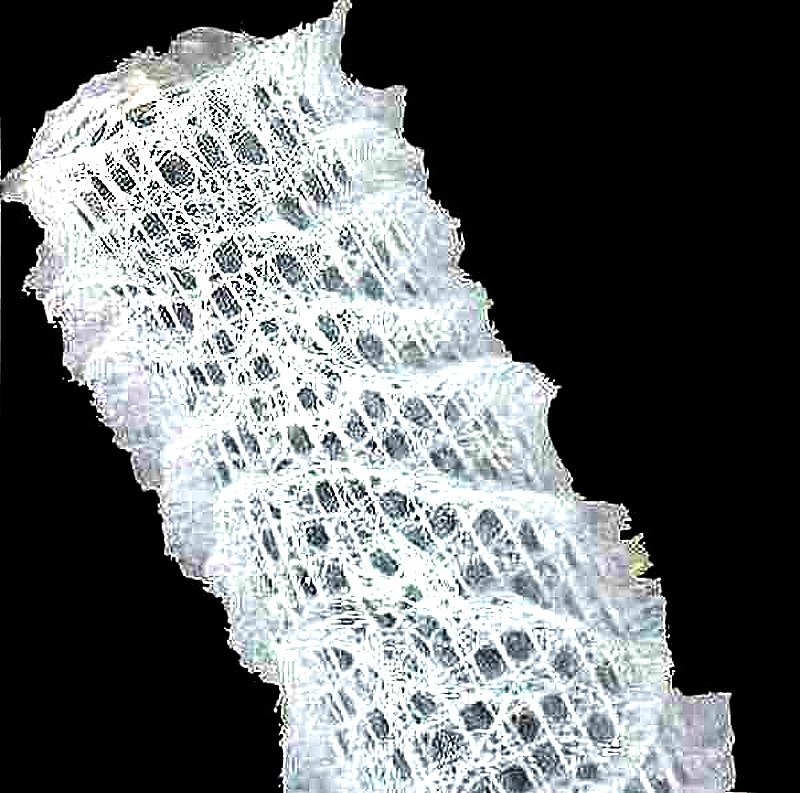
Another remarkable spicule which also occurs in Hyalonema is the so-called “dumbbell spicule”. See how inventive Nature is.
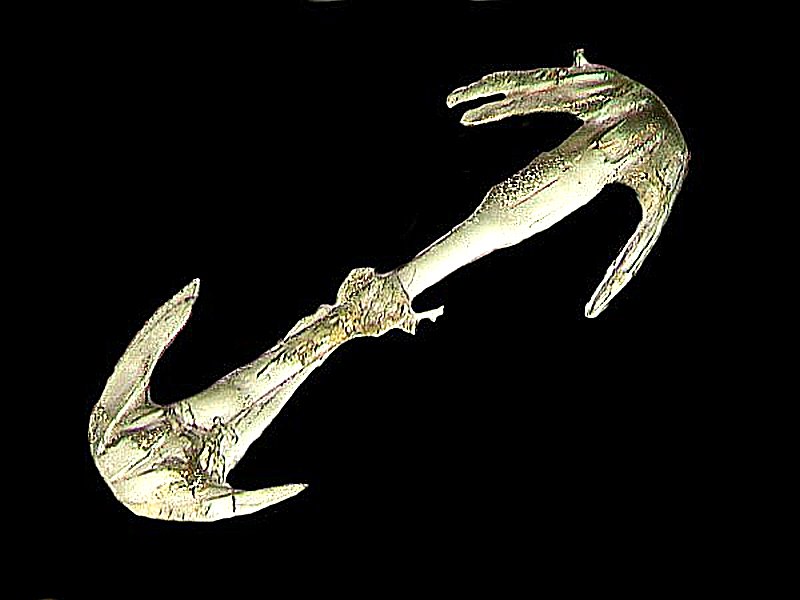
Furthermore, did you know that Nature invented the wheel, long before we were around. This spicule is from a small sea cucumber, Chirodota, and was photographed using DIC.
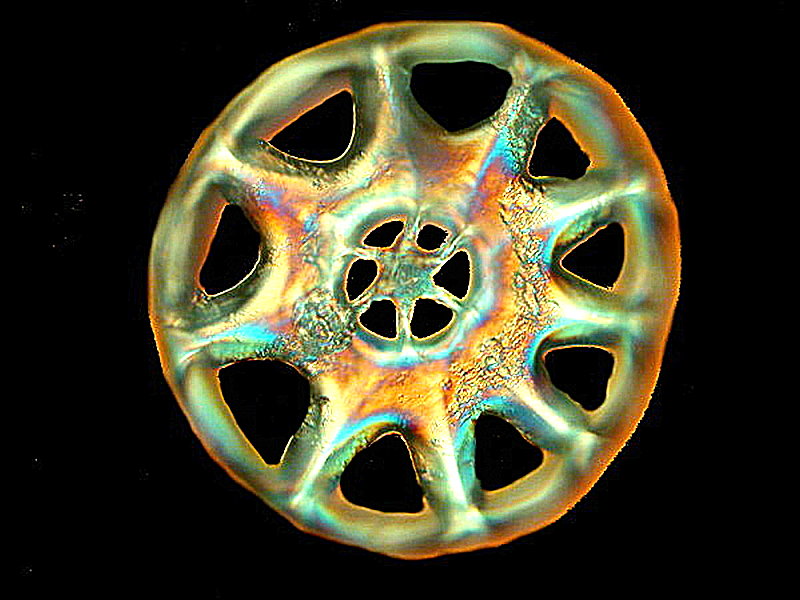
And, here it is in a formative stage–looks like some kind of toy for aliens.
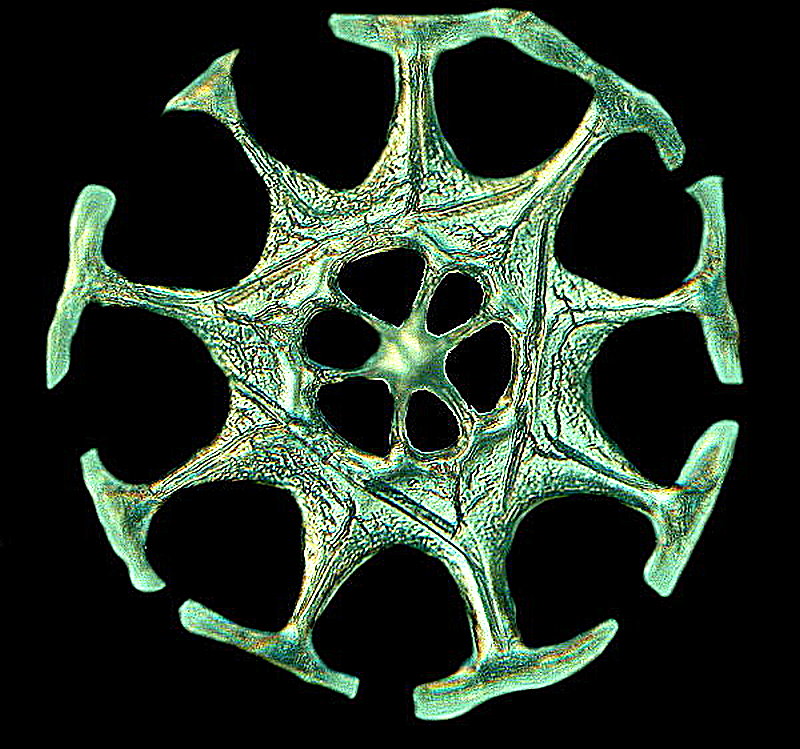
While we’re looking at structures in echinoderms, let’s look at a part of one from a sea urchin. It’s called a pedicellaria; they come in 3 or 4 fairly common types. The part we’re going to be looking at is from one of the types that has “jaws” composed of 3 parts which can close and capture and kill larvae drifting down onto the surface and without these tiny “disposal” units, the larvae would likely settle in and take up residence. What we are going to be looking at is just one of the 3 components that forms a “jaw”–and you will here be able to see that Nature also invented the lute. These are colorful images taken with DIC and use the prisms to create “optical staining”.
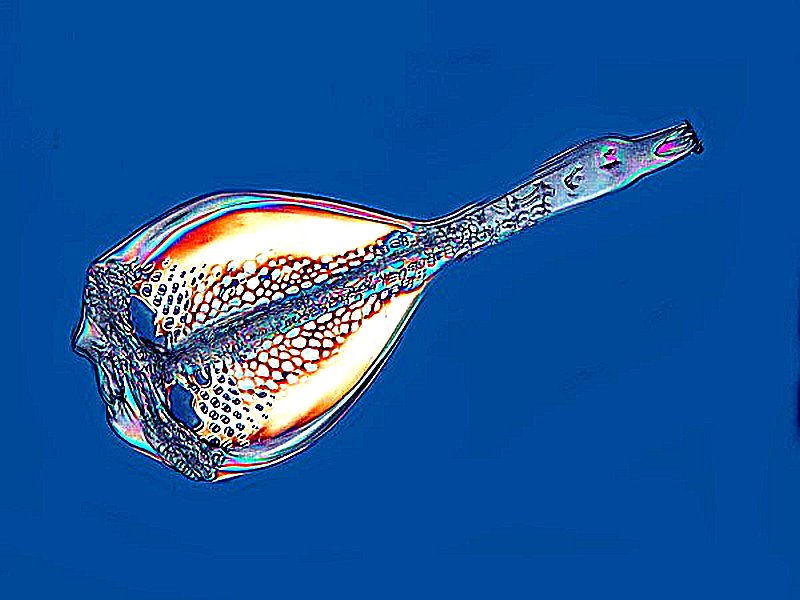
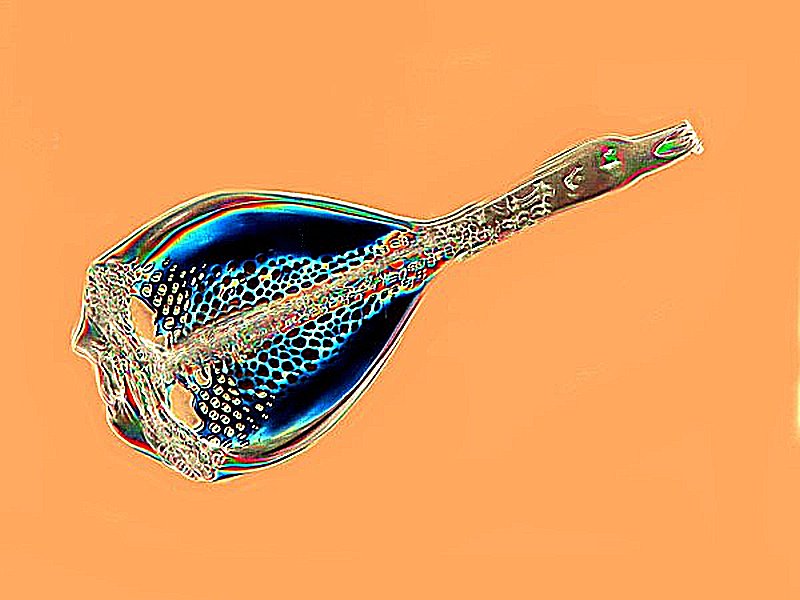
Let’s consider one more set of examples and then I will give a very brief summary. Humans can take on remarkable creative tasks using natural objects and produce compositions of extraordinary beauty using items which already have an intrinsic beauty. What I am going to show you now is a few images where microscopists have taken diatoms and created lovely arrangements of them. I have used a variety of illumination techniques and I won’t talk in detail about the images; I’ll just leave you to enjoy their richness. First, I’ll show you 5 image arrangements and then 3 closeups.
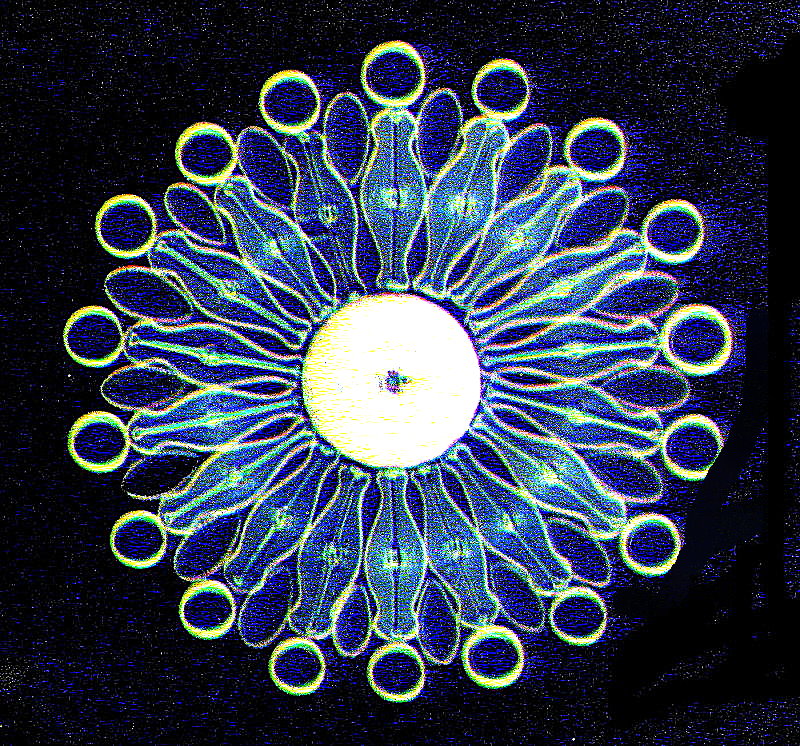
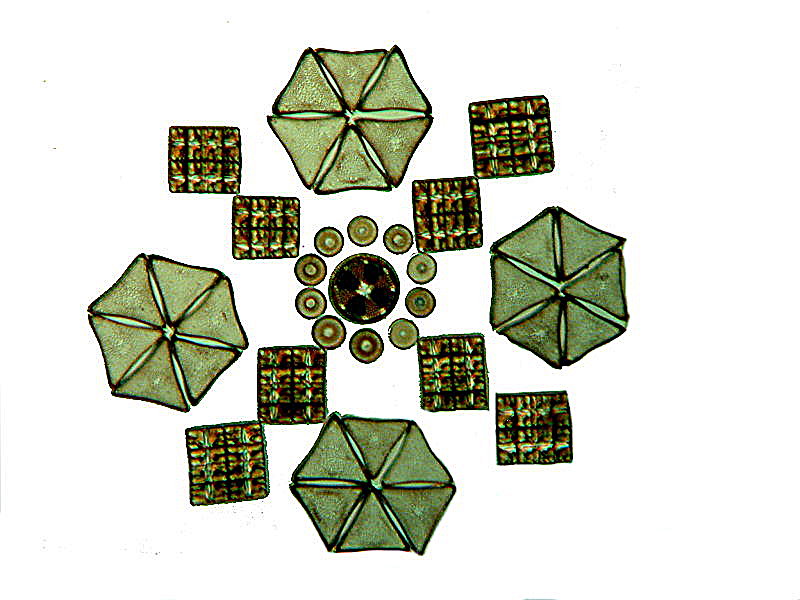
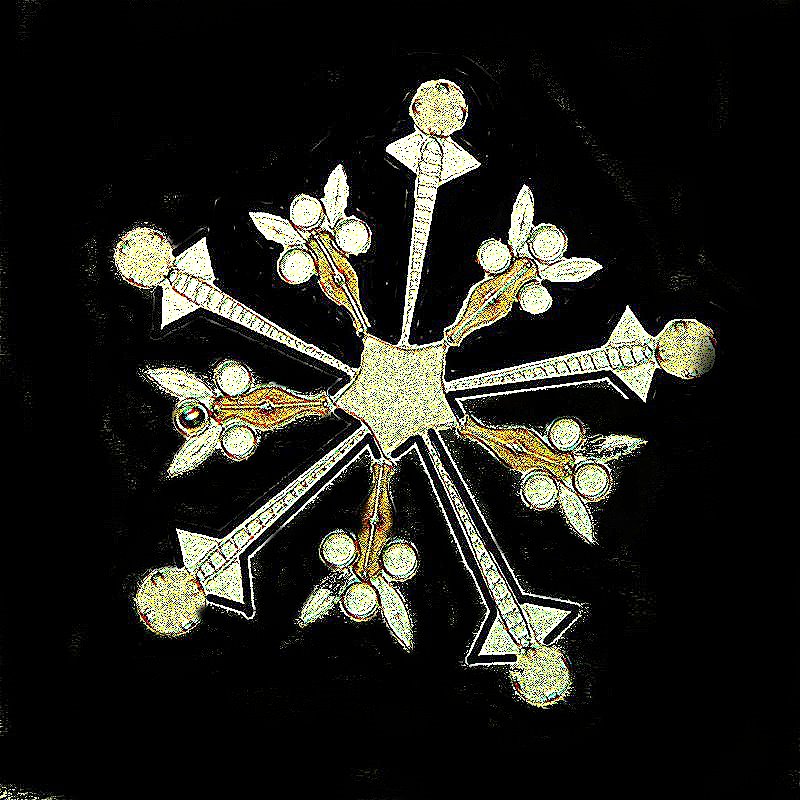


And here are the closeups.
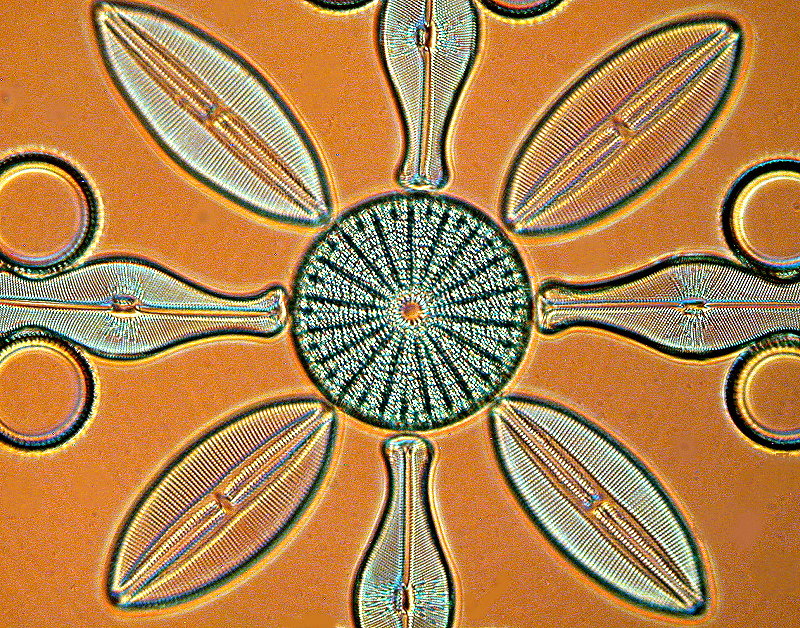
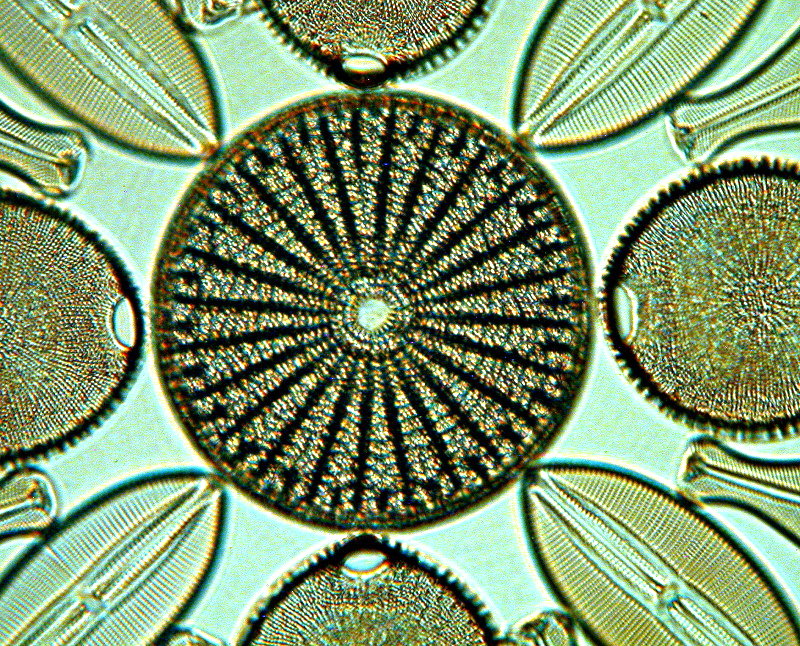
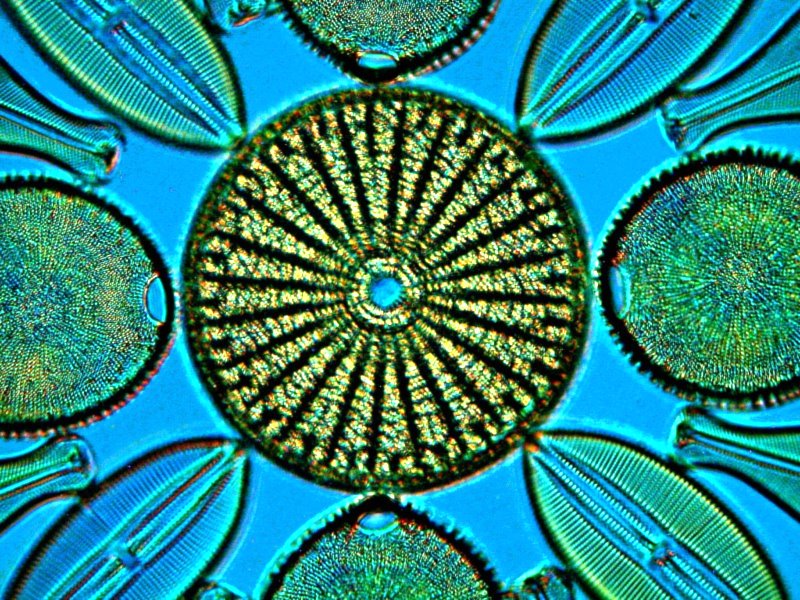
There are literally millions of other organisms that are of extraordinary beauty and/or complexity and you can discover many of them by going on Google and searching for “beautiful sponges, or feather stars, tunicates, fossils, minerals, tropical fish, sea urchins, nudibranchs,” and on and on.
Finally, we are free to indulge in romanticizing Nature and extolling it’s beauty and intricacy, but we forget the dark side at our own risk, for Nature can be powerfully destructive and while this is a side we don’t like to dwell on, it is imperative that we pay careful attention to it, because such considerations affect our survival as a species. Such contemplations might also serve to remind us that we need to keep our own nature under certain degrees of rational control, since we have proven that we ourselves are very destructive organisms.
All comments to the author Richard Howey
are
welcomed.
If email software is not linked to a browser, right click above link and use the copy email address feature to manually transfer.
Editor's note: Visit Richard Howey's new website at http://rhowey.googlepages.com/home where he plans to share aspects of his wide interests.
Microscopy UK Front
Page
Micscape
Magazine
Article
Library
Published in the February 2022 edition of Micscape Magazine.
Please report any Web problems or offer general comments to the Micscape Editor .
Micscape is the on-line monthly magazine of the Microscopy UK website at Microscopy-UK .
©
Onview.net Ltd, Microscopy-UK, and all contributors 1995
onwards. All rights reserved.
Main site is at
www.microscopy-uk.org.uk .